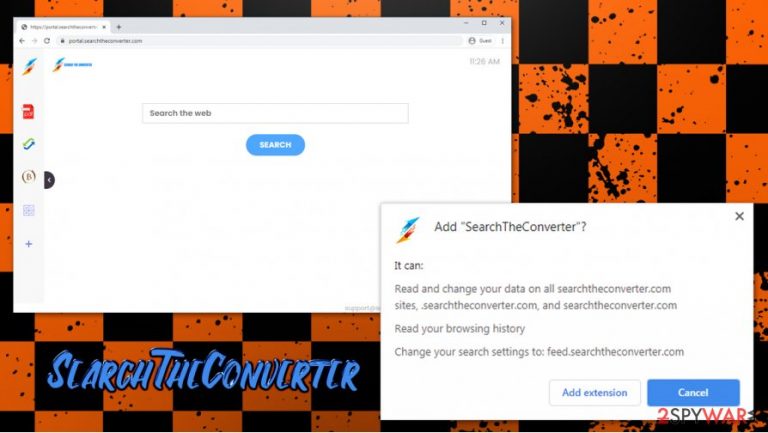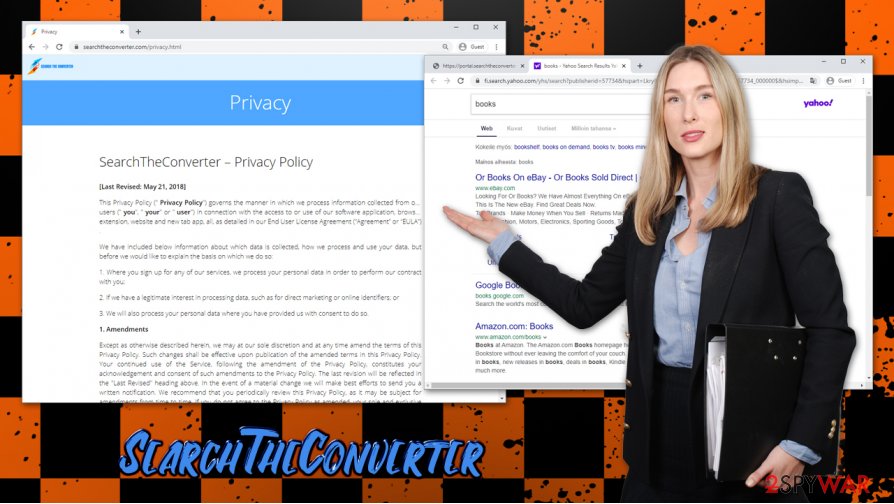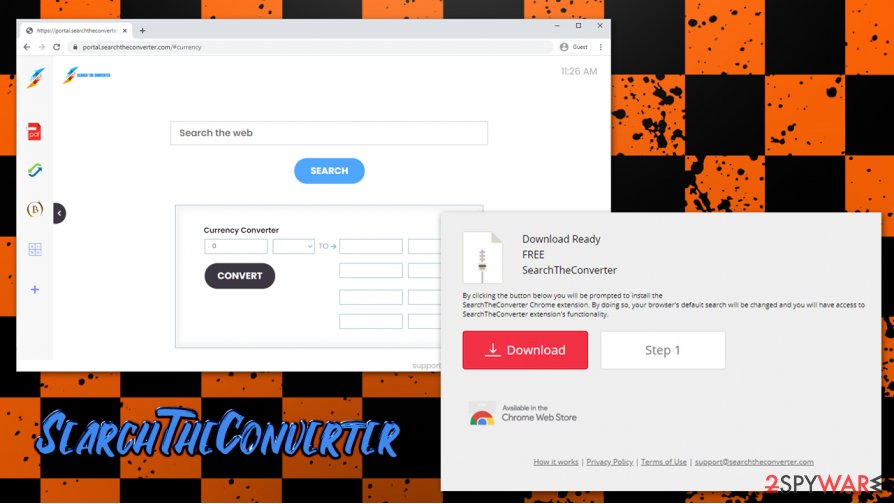SearchTheConverter (Easy Removal Guide) - Free Instructions
SearchTheConverter Removal Guide
What is SearchTheConverter?
SearchTheConverter is a browser hijacker designed to show you ads while gathering your data in the background

SearchTheConverter is a fake search tool that usually shows up on users' browsers unexpectedly, as it is commonly downloaded along with other software from various third-party websites. In other cases, it can also be installed intentionally or after being tricked by a deceptive advertisement, as well as a fake update.
The hijacker typically shows up as an extension on Google Chrome, Mozilla Firefox, Safari, or another web browser, although it can also be related to a standalone program installed on a Windows or Mac computer. Upon infiltration, it changes the homepage and new tab URL to portal.searchtheconverter.com, applies a customized search tool and delivers all the search results via Yahoo engine.
Due to altered web browser settings, SearchTheConverter can insert sponsored links into searches, increase the number of ads all around the web, and track users' online activities for marketing purposes. Browser hijackers, while generally not dangerous, can possess a variety of negative qualities that should not be ignored if privacy and safety are valued.
| Name | SearchTheConverter |
| Type | Browser hijacker, potentially unwanted program |
| Distribution | You can install a PUP when downloading freeware from third-party sites. Additionally, you may also have been tricked by a fake update prompt or a deceptive ad |
| Symptoms | SearchTheConverter browser extension or another unidentified application installed on the system; portal.searchtheconverter.com is set as a default homepage and new tab URL; a customized search engine redirects all search results via Yahoo, filled with sponsored links at the top; |
| Dangers | In most cases, no high risks are associated with a browser hijacker, although its infection can sometimes result in privacy issues, monetary losses or infiltration of other potentially unwanted programs |
| Removal | To get rid of an extension or the installed application, follow the instructions we provide below. Alternatively, you can scan the machine with anti-malware software such as SpyHunter 5Combo Cleaner |
| Optional steps | If your security software detected some issues, we highly recommend resetting all the installed web browsers and then repairing possible system damage with FortectIntego |
Since SearchTheConverter might enter users' machines without permission, users might believe that the app is a virus. While this type of terminology might be justified, it is not technically correct, as browser hijackers are generally considered minor computer threats. Nevertheless, it does not mean that they should be completely ignored, especially since the unexpected appearance of unsolicited apps might also indicate that malware is also present in the system.
The so-called SearchTheConverter virus, in particular, stems from a broad browser hijacking family, members of which include TiktokSearches, PDFSearchio, AllConvertersSearch, and many others. On the surface, it might seem to many that these browser hijackers have quite a few useful features, such as a built-in currency converter or a calculator. However, these features are just one part of SearchTheConverter hijack, and there are plenty of invisible activities that might never be disclosed to the end-user.
Upon infiltration, the PUP will perform several changes to the web browser, for example:
- A SearchTheConverter extension installed on the web browser
- Homepage and new tab address is set to portal.searchtheconverter.com
- All search results are redirected from a customized search engine to search.yahoo.com
- Web browser might operate slower than usual.
Keep in mind that the extension is not the only reason for these browser changes – SearchTheConverter removal would differ in such cases. Instead of simply removing the extension via your browser, you would have to access the list of the installed apps and eliminate all the suspicious ones. Another good way to terminate PUPs is by scanning the machine with powerful anti-malware software.

While unexpected browser changes can be noticed by users straight away, underlying activities are seldom evident to them. For the most part, browser hijackers are set to collect a variety of anonymous and personal information about users, which is sometimes shared with business partners and third-parties. In the case of SearchTheConverter, technical data (browser type, system details), online activities (search terms, browsing history, links clicked), as well as personal identifiers (IP address) are collected as long as the app is installed on the device.
Another reason to remove SearchTheConverter is the altered search settings and how it affects users' web browsing routines. For example, instead of clicking on a genuine search result provided by trusted search providers, users will always be shown ads at the top, which can greatly diminish web browsing experience and sometimes even hinder the ability to find relevant information.
To get rid of SearchTheConverter ads and search redirects, you should uninstall the extension or another potentially unwanted program from your computer. After that, experts also advise performing additional checks with anti-malware and repair software such as FortectIntego.
Good online practices can prevent the infiltration of unwanted software
There is no surprise that most browser hijackers and adware gain access to users' machines without asking for direct permission, i.e., they typically find these unwanted apps seemingly out of nowhere. While this approach has some merit to it, it is not entirely correct, as PUPs do not spread as malware does. In other words, users install potentially unwanted applications themselves, even though they are mostly tricked into doing so.
Nonetheless, there are several methods to avoid potentially unwanted applications completely – and you do not need to be a PC expert for that. Here are a few tips that would help you prevent unintentional installation of dubious software on your computer:
- If possible, download applications from official websites only;
- Do not download updates for Flash via random prompts on the internet (the plugin is outdated, flawed, and soon to be discontinued – you do not need it in the first place);
- Avoid sites that offer pirated program installers or software cracks;
- During the installation of a new app, always pick Advanced/Custom mode instead of Recommended/Quick one when prompted and then remove all of the ticks from checkboxes;
- Install a robust anti-malware software with real-time protection feature on – it could warn you about the incoming infections, preventing them altogether.

Delete SearchTheConverter at once
SearchTheConverter removal should not be complicated – all you have to do is right-click on the add-on and then uninstall it. Nonetheless, some browser hijackers from the same family are known to set the “Managed by your organization” status on Google Chrome or Mozilla Firefox web browsers, which would prevent a successful uninstallation of the app.
Luckily, there is a way to bypass such functionality easily. If you struggle to remove SearchTheConverter due to restrictions, we suggest you simply reset the installed web browsers as we explain below. Besides, we also provide details on how to uninstall potentially unwanted programs from Windows and Mac computers easily.
However, if you want to get rid of the SearchTheConverter virus quickly or you did not succeed when trying to do it manually, you should make use of anti-malware software – simply scan the computer thoroughly.
You may remove virus damage with a help of FortectIntego. SpyHunter 5Combo Cleaner and Malwarebytes are recommended to detect potentially unwanted programs and viruses with all their files and registry entries that are related to them.
Getting rid of SearchTheConverter. Follow these steps
Uninstall from Windows
To uninstall potentially unwanted programs from Windows machines, you should reach the Control Panel:
Instructions for Windows 10/8 machines:
- Enter Control Panel into Windows search box and hit Enter or click on the search result.
- Under Programs, select Uninstall a program.

- From the list, find the entry of the suspicious program.
- Right-click on the application and select Uninstall.
- If User Account Control shows up, click Yes.
- Wait till uninstallation process is complete and click OK.

If you are Windows 7/XP user, proceed with the following instructions:
- Click on Windows Start > Control Panel located on the right pane (if you are Windows XP user, click on Add/Remove Programs).
- In Control Panel, select Programs > Uninstall a program.

- Pick the unwanted application by clicking on it once.
- At the top, click Uninstall/Change.
- In the confirmation prompt, pick Yes.
- Click OK once the removal process is finished.
Delete from macOS
macOS users should follow these steps to eliminate unwanted apps:
Remove items from Applications folder:
- From the menu bar, select Go > Applications.
- In the Applications folder, look for all related entries.
- Click on the app and drag it to Trash (or right-click and pick Move to Trash)

To fully remove an unwanted app, you need to access Application Support, LaunchAgents, and LaunchDaemons folders and delete relevant files:
- Select Go > Go to Folder.
- Enter /Library/Application Support and click Go or press Enter.
- In the Application Support folder, look for any dubious entries and then delete them.
- Now enter /Library/LaunchAgents and /Library/LaunchDaemons folders the same way and terminate all the related .plist files.

Remove from Microsoft Edge
Delete unwanted extensions from MS Edge:
- Select Menu (three horizontal dots at the top-right of the browser window) and pick Extensions.
- From the list, pick the extension and click on the Gear icon.
- Click on Uninstall at the bottom.

Clear cookies and other browser data:
- Click on the Menu (three horizontal dots at the top-right of the browser window) and select Privacy & security.
- Under Clear browsing data, pick Choose what to clear.
- Select everything (apart from passwords, although you might want to include Media licenses as well, if applicable) and click on Clear.

Restore new tab and homepage settings:
- Click the menu icon and choose Settings.
- Then find On startup section.
- Click Disable if you found any suspicious domain.
Reset MS Edge if the above steps did not work:
- Press on Ctrl + Shift + Esc to open Task Manager.
- Click on More details arrow at the bottom of the window.
- Select Details tab.
- Now scroll down and locate every entry with Microsoft Edge name in it. Right-click on each of them and select End Task to stop MS Edge from running.

If this solution failed to help you, you need to use an advanced Edge reset method. Note that you need to backup your data before proceeding.
- Find the following folder on your computer: C:\\Users\\%username%\\AppData\\Local\\Packages\\Microsoft.MicrosoftEdge_8wekyb3d8bbwe.
- Press Ctrl + A on your keyboard to select all folders.
- Right-click on them and pick Delete

- Now right-click on the Start button and pick Windows PowerShell (Admin).
- When the new window opens, copy and paste the following command, and then press Enter:
Get-AppXPackage -AllUsers -Name Microsoft.MicrosoftEdge | Foreach {Add-AppxPackage -DisableDevelopmentMode -Register “$($_.InstallLocation)\\AppXManifest.xml” -Verbose

Instructions for Chromium-based Edge
Delete extensions from MS Edge (Chromium):
- Open Edge and click select Settings > Extensions.
- Delete unwanted extensions by clicking Remove.

Clear cache and site data:
- Click on Menu and go to Settings.
- Select Privacy, search and services.
- Under Clear browsing data, pick Choose what to clear.
- Under Time range, pick All time.
- Select Clear now.

Reset Chromium-based MS Edge:
- Click on Menu and select Settings.
- On the left side, pick Reset settings.
- Select Restore settings to their default values.
- Confirm with Reset.

Remove from Mozilla Firefox (FF)
Remove dangerous extensions:
- Open Mozilla Firefox browser and click on the Menu (three horizontal lines at the top-right of the window).
- Select Add-ons.
- In here, select unwanted plugin and click Remove.

Reset the homepage:
- Click three horizontal lines at the top right corner to open the menu.
- Choose Options.
- Under Home options, enter your preferred site that will open every time you newly open the Mozilla Firefox.
Clear cookies and site data:
- Click Menu and pick Settings.
- Go to Privacy & Security section.
- Scroll down to locate Cookies and Site Data.
- Click on Clear Data…
- Select Cookies and Site Data, as well as Cached Web Content and press Clear.

Reset Mozilla Firefox
If clearing the browser as explained above did not help, reset Mozilla Firefox:
- Open Mozilla Firefox browser and click the Menu.
- Go to Help and then choose Troubleshooting Information.

- Under Give Firefox a tune up section, click on Refresh Firefox…
- Once the pop-up shows up, confirm the action by pressing on Refresh Firefox.

Remove from Google Chrome
If you struggle with some extension removal from Chrome, reset it as explained below:
Delete malicious extensions from Google Chrome:
- Open Google Chrome, click on the Menu (three vertical dots at the top-right corner) and select More tools > Extensions.
- In the newly opened window, you will see all the installed extensions. Uninstall all the suspicious plugins that might be related to the unwanted program by clicking Remove.

Clear cache and web data from Chrome:
- Click on Menu and pick Settings.
- Under Privacy and security, select Clear browsing data.
- Select Browsing history, Cookies and other site data, as well as Cached images and files.
- Click Clear data.

Change your homepage:
- Click menu and choose Settings.
- Look for a suspicious site in the On startup section.
- Click on Open a specific or set of pages and click on three dots to find the Remove option.
Reset Google Chrome:
If the previous methods did not help you, reset Google Chrome to eliminate all the unwanted components:
- Click on Menu and select Settings.
- In the Settings, scroll down and click Advanced.
- Scroll down and locate Reset and clean up section.
- Now click Restore settings to their original defaults.
- Confirm with Reset settings.

Delete from Safari
Remove unwanted extensions from Safari:
- Click Safari > Preferences…
- In the new window, pick Extensions.
- Select the unwanted extension and select Uninstall.

Clear cookies and other website data from Safari:
- Click Safari > Clear History…
- From the drop-down menu under Clear, pick all history.
- Confirm with Clear History.

Reset Safari if the above-mentioned steps did not help you:
- Click Safari > Preferences…
- Go to Advanced tab.
- Tick the Show Develop menu in menu bar.
- From the menu bar, click Develop, and then select Empty Caches.

After uninstalling this potentially unwanted program (PUP) and fixing each of your web browsers, we recommend you to scan your PC system with a reputable anti-spyware. This will help you to get rid of SearchTheConverter registry traces and will also identify related parasites or possible malware infections on your computer. For that you can use our top-rated malware remover: FortectIntego, SpyHunter 5Combo Cleaner or Malwarebytes.
How to prevent from getting browser hijacker
Access your website securely from any location
When you work on the domain, site, blog, or different project that requires constant management, content creation, or coding, you may need to connect to the server and content management service more often. The best solution for creating a tighter network could be a dedicated/fixed IP address.
If you make your IP address static and set to your device, you can connect to the CMS from any location and do not create any additional issues for the server or network manager that needs to monitor connections and activities. VPN software providers like Private Internet Access can help you with such settings and offer the option to control the online reputation and manage projects easily from any part of the world.
Recover files after data-affecting malware attacks
While much of the data can be accidentally deleted due to various reasons, malware is one of the main culprits that can cause loss of pictures, documents, videos, and other important files. More serious malware infections lead to significant data loss when your documents, system files, and images get encrypted. In particular, ransomware is is a type of malware that focuses on such functions, so your files become useless without an ability to access them.
Even though there is little to no possibility to recover after file-locking threats, some applications have features for data recovery in the system. In some cases, Data Recovery Pro can also help to recover at least some portion of your data after data-locking virus infection or general cyber infection.
